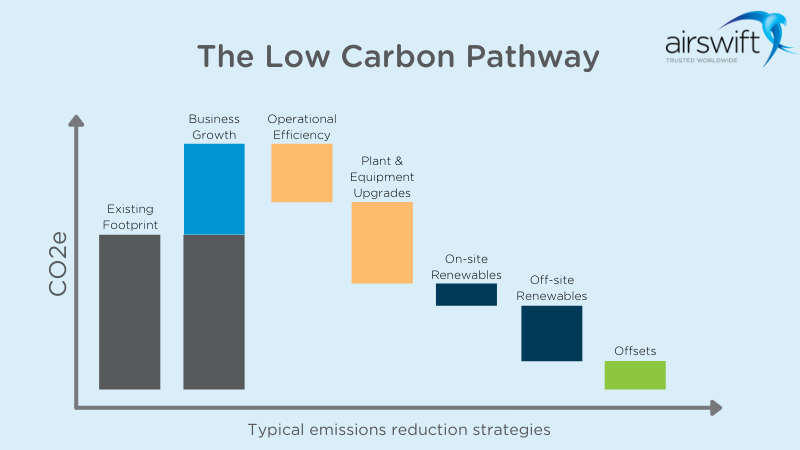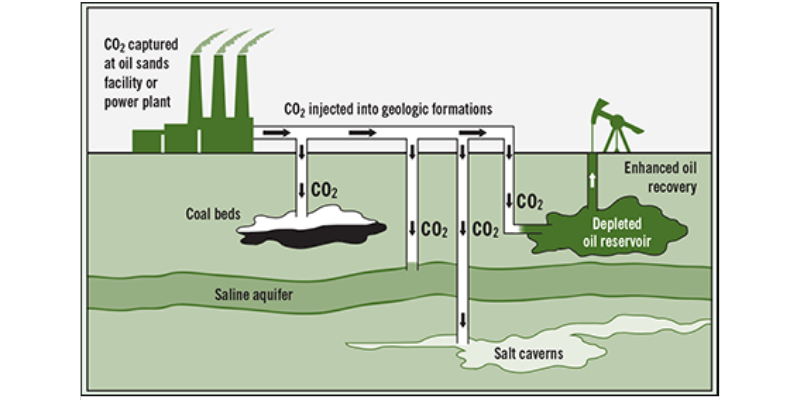By
Guest Author
June 17, 2021
Updated
September 15, 2022
Carbon reduction targets intertwine with most current discussions about oil and gas
Increased interest in the energy transition has put carbon emissions targets at the forefront. It seems that firms that improve industrial processes, technology and skills will transition quickest.
But, the question of how to reduce carbon emissions is a large part of the challenge itself.
- Is it a technology question?
- A skills issue?
- A geopolitical debate?
- Or a question of motivation?
Or a combination of all four?
Reducing the carbon footprint is a challenge for individuals and companies. Accomplishing this through carbon capture technology is achievable when managed by capable professionals. It must first be defined and then a management plan implemented.
In this article, guest author, Nick Vaccaro will discuss
- Key terminology and policies related to carbon reduction
- How university degree programs teach the subject
- The impact on oil and gas jobs and skills demands within the energy industry
Interested in how carbon reduction policies could define your career? Read on….
Why is there increasing demand to reduce carbon emissions?
Increasing concerns about emissions led to most nations agreeing to reductions as part of the Paris Agreement.
Enacted in Dec 2015, the agreement set global warming targets and to reduce gas emissions. The signatories agreed to limit global temperature increases to 1.5° Celsius. 189 countries have agreed to reduce emissions and collaborate to combat climate change.
To meet the 1.5°C targets, carbon emissions must reach 'net-zero' by the middle of the century.
Net-zero serves as a concept in describing a simple balance. For any quantity of greenhouse gas emitted, an equal amount must be removed from the atmosphere.
COP26
The upcoming United Nations climate summit, known as COP26, promises that 2021 will be the turning point in the global climate crisis.
Citing failures to meet Paris targets, the coalition emphasised the importance of escalating reductions by 2030.
Partnering to host COP26, the UK and Italian governments have established four goals specific to the event:
- Finding common ground in incremental commitments in the reduction of emissions.
- Fortifying the acceptance of the climate change impact.
- Establishing and securing financing for climate action.
- Furthering collaboration of international partners in energy transition along with improved transport and nature.
When comparing the players, the United States and China both committed to net-zero emissions by 2050. New Zealand, South Korea, and Japan plan to strengthen their positions before the COP26 summit.
What is carbon reduction?

Data compiled from Envizi 2020
When discussing the legitimacy of the climate crisis, emissions become a hot topic of debate.
Carbon reduction refers to the process of decreasing carbon dioxide concentrations in the atmosphere.
Often referred to as reducing the carbon footprint, the process is accomplished through one of two approaches.
- First, a carbon tax can be applied to the fossil fuel industry. The tax would involve a specified percentage added to the cost of gasoline or household utility usage.
- The alternative measure involves a cap-and-trade system that controls carbon emissions through limitation. An upper limit would be established for a certain business. This would dictate how much carbon dioxide could be produced. It also allows those same businesses to purchase additional capacity from other businesses that refrain from meeting their allowance cap.
Carbon capture and storage
Attempting to reduce their carbon footprint, companies are engaging in a variety of reduction methods.
One example is carbon capture. This refers to the process of containing excess carbon dioxide and delivering it to a location for safe storage. This then avoids its transfer into the atmosphere.

Source: energywatch-inc.com
Another involves taking excess carbon dioxide and pairing it with hydrogen to yield hydrocarbon fuel used in synthetic markets. Carbon dioxide proves to have a significant impact in curing aggregates. The more popular practice involves injecting carbon dioxide into existing oil and gas wells to increase production.
No matter the process, companies must find skilled professionals to manage such details and industrial processes.
These individuals find themselves tasked with overseeing their companies’ carbon footprint reduction standards and goals.
The challenge lies in locating the workforce with the skillset to accomplish such tasks as carbon capture utilisation and storage.
Finding carbon reduction talent through the university system

Source: Adamov_d/Shutterstock
To understand the future carbon reduction workforce, I spoke to academics.
Ironically, one will not locate a degree in carbon reduction on any university website.
Instead, carbon reduction on the university level is a broader term linked to a range of subjects.
I spoke to Dr Milton Saidu, PhD to find out more about current teaching. Dr Saidu serves as the Department Head of the Petroleum Engineering Technology and Safety Management program at Nicholls State University in Thibodaux, LA. The curriculum includes various courses that both, directly and indirectly, discuss carbon reduction.
“Careers that involve carbon reduction are embedded in our courses,” said Dr Saidu.
According to Dr Saidu, Nicholls’ Environmental Technology course covers regulations enforced by the Environmental Protection Agency and discusses flaring. Industrial hygiene courses include a sequence on measurements and exposure to the environment and not just humans.
On the exploration and production side, additional methods are used to incorporate processes of carbon reduction.
For instance, the program contains a drilling simulator to apply practical learning. This teaches an understanding of the process and ways to enhance oil recovery
For Dr Saidu, this simulation is a direct example of reducing carbon. It provides the closest comparison to real workplace experience. This provides students with the ability to understand their vocation before they get to the workplace. They can perform job tasks correctly and cut wasted time and materials.
“We try to prepare students to be critical thinkers,” said Dr Saidu. “Simulation is the key to reducing the carbon footprint.”
The Nicholls’ curriculum also contains carbon reduction within its Safety Control Systems courses. Here educating students on programmable systems allows them to be turned on and off as needed. This is the key to efficiency, which leads to refraining from wasting energy. This in its essence is the pathway to carbon reduction and improved power generation.
Dr Saidu stated that the same thought process applies to preparation for careers as Drill Site and Production Managers. Providing an education that teaches these individuals to manage power and avoid energy waste directly leads to carbon reduction.
“It goes back to energy efficiency,” said Dr Saidu.
“Understanding the processes and controlling the flow can reduce the energy being used. All our courses speak of efficiency. Nicholls does not present a specific degree in carbon reduction but instead includes the concept in all our courses relevant to oil and gas. Professional direction from our program prepares students to reduce their carbon footprint. No matter the job title they end up with.”
Who’s hiring?
What about existing workers within oil and gas? How do emissions regulations determine what the industry offers in carbon reduction careers?
Airswift is an industry leader in oil and gas industry recruitment. According to Jason Goodall, Strategic Accounts Director, a true measure of carbon reduction jobs is difficult to define.
“We don’t have a true terminology,” said Goodall referring to the identification of these types of careers.
According to Goodall, companies are not requesting candidates for specific carbon reduction roles. Instead, the need is identified in job descriptions for other specialisms.
“Most jobs associated with carbon reduction are rooted in HSE and engineering,” said Goodall. “Those jobs are going more and more renewable.”
The renewables sector, stated Goodall, contains the focus on reducing the carbon footprint. But the concept is not new to the oil and gas industry.
“Carbon reduction has been a big part of oil and gas for years, but it has not been identified specifically. Oil and gas has concentrated on carbon reduction for many years through practices such as reinjecting wells.”
When analyzing the current data and statistics, Goodall stated that there are only 11 actual carbon reduction projects activein the United States. And they are not exclusive to the oil and gas industry.
Instead, carbon reduction finds placement within the oil and gas sector as part of job descriptions to other career positions. So, while carbon reduction is important, it is not being demanded directly.
“The terminology for carbon reduction careers is not present yet. But it will develop in response to negative perception,” said Goodall.
“Not addressing carbon reduction will result in negative press. This can drive share prices down. Investors want a more diverse portfolio. So, companies are and will continue to address emissions issues.”
Looking ahead

Carbon reduction careers will remain but also intensify as the oil and gas industry and the energy transition progresses.
Until the terminology is derived specifically for a career of this subject matter, Goodall believes the system will remain as it is.
He believes more emphasis should be placed on where jobs dealing with carbon reduction, such as deep underground storage, will be situated.
“Carbon reduction jobs will lie within projects,” said Goodall.
“Projects such as storage facilities will be where most carbon reduction jobs will reside. With the major developments in technology and the overwhelming push to automation, I don’t think the future will show these jobs on the operations side.
Headcounts will be decreased with the implementation of machines. Projects will be the key player in carbon careers before turning on and operating on the automation side.”
